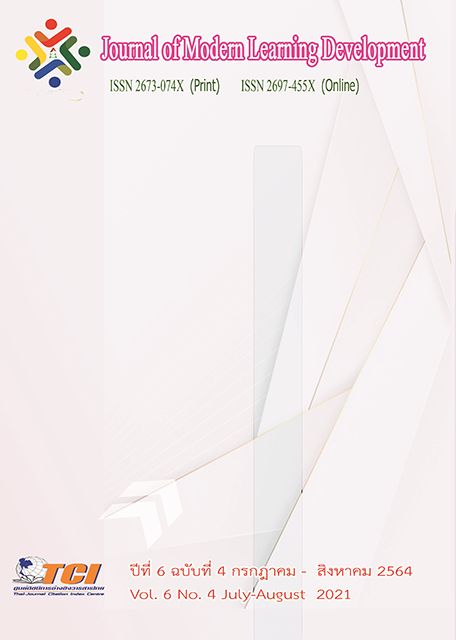The Construction of a Media Literacy Test for Student Grade 11 in Secondary School at the Secondary Educational Service Area Office Sakon Nakhon
Main Article Content
Abstract
The purposes of this research were to build, find quality and to build norms of a media literacy test for student grade 11 in secondary school at the secondary educational service area office sakon Nakhon The sample of this research consisted of 376 grade 11 students. Acquired by using the G*Power analysis program and Multi-stage Sampling. Questionnaire was used as research tool which had IOC value (Item – Objective Congruence) between 0.80 – 1.00. The statistics used in research were Confirmatory Factor Analysis, Percentile, ad T-Score.
A result of this study was found in the following aspects.
1) Create and find the construction of a media literacy test for student grade 11 in secondary school at the secondary educational service area office sakon Nakhon There are
5 components and 30 Indicator of Create skill, Analyze skill, Evaluate skill,Participate skill,and Access skill. They feature questions Current situation media literacy test, with having 3 options and a score of 0,1, 2, a total of 30 items The qualitative of media literacy test for student grade 11 in secondary school at the secondary educational service area office sakon Nakhon content validity was in the Discriminative power of 30-item test was from 0.619 to 0.852. The reliability of media literacy test was 0.979. Construct validity by Confirmatory Factor Analysis : CFA Of The chi–square value of 97.46The factor loading is the weight of high is Access skill, Analyze skill 0.991, Evaluate skill 0.938 , Participate skill 0.938 and The weight of low is of Create skill.
2) Norms score by Normalized T-Score. It was found that thenormal values, ranging from T 20 to T63 showed that 376 students were able to a media literacy skill the high barriers of 100 and 26.59% , moderate 174 and 46.28%, and low level 100 and 27.12%.
Article Details
References
ทรงศักดิ์ ภูศรีอ่อน. (2558). การประยุกต์ใช้ SPSS วิเคราะห์ข้อมูลงานวิจัย. กาฬสินธุ์: ประสานการพิมพ์.
ปกรณ์ ประจันบาน และ อนุชา กอนพ่วง. (2558). การวิจัยและพัฒนาแบบวัดทักษะในศตวรรษที่ ๒๑ ด้านการรู้เท่าทันสื่อ ของนักเรียนชั้นมัธยมศึกษา. คณะศึกษาศาสตร. บัณฑิตวิทยาลัย: มหาวิทยาลัยนเรศวร.
พรทิพย์ เย็นจะบก. (2558). เด็กไทยรู้เท่าทันสื่อ ฉลาดรู้ ฉลาดเลือก. กรุงเทพมหานคร: สำนักงานปลัดกระทรวงวัฒนธรรม สำนักเฝ้าระวังทางวัฒนธรรม.
พรรณพิมล วิปุลากร และคณะ. (2553). ห้าสิบปีสถาบันราชานุกูล. กรุงเทพมหานคร: สถาบันราชานุกูล กรมสุขภาพจิต กระทรวงสาธารณสุข.
พิชิต ฤทธิ์จรูญ. (2545). หลักการวัดและประเมินผลการศึกษา. กรุงเทพมหานคร: เฮ้าส์ ออฟ เคอร์มิสท์.
มูลนิธิอินเทอร์เน็ตร่วมพัฒนาไทย. (2555). รู้เท่าทันสื่อ ICT. กรุงเทพมหานคร: บริษัท เอเซีย แปซิฟิก ออฟเซ็ท จำกัด.
วราพร เอราวรรณ์. (2563). การวิเคราะห์ข้อมูลด้วยโปรแกรม Mplus. กรุงเทพมหานคร: มูลนิธิสถาบันวิจัยระบบการศึกษา.
สมนึก ภัททิยธนี. (2551). การวัดผลการศึกษา. กาฬสินธุ์: ประสานการพิมพ์.
สมนึก ภัททิยธนี. (2556). เทคนิคการสอนคณิตศาสตร์ ระดับประถมศึกษา. กาฬสินธุ์: ประสานการพิมพ์.
อุบลรัตน์ ศิริยุวศักดิ์. (2548). ปิดหู ปิดตา ปิดปาก : สิทธิเสรีภาพในมือธุรกิจการเมืองสื่อ. กรุงเทพมหานคร: คณะนิเทศศาสตร์ จุฬาลงกรณ์มหาวิทยาลัย.
Thoman, E., & Jolls, T. (2003). Literacy for the 21st Century: An Overview & Orientation Guide to Media Literacy Education Santa Monica, CA: Center for Media Literacy.


